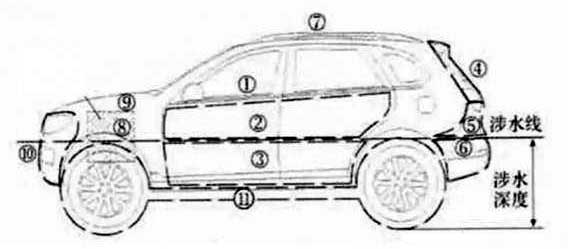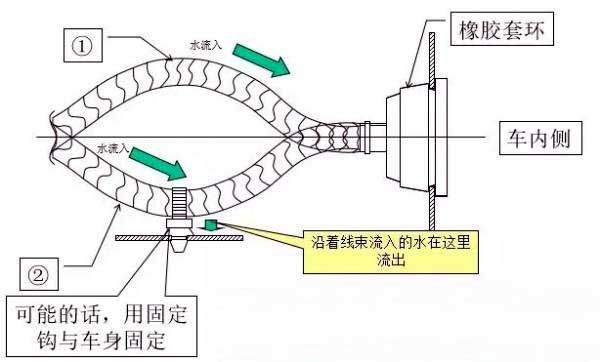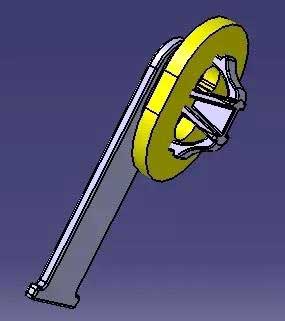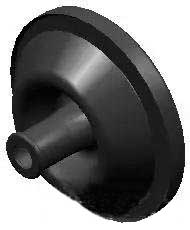Detailed explanation of waterproof design of automobile wiring harness
The automobile low-voltage wiring harness connects the various electrical devices on the entire vehicle, plays the role of energization and signal transmission, and is the nervous system of the automobile. In order to ensure the stability of the wiring harness system, it is necessary to combine the working environment of each area of the vehicle to determine the corresponding protection design for the wiring harness in each area. Water resistance is an important part of wiring harness design, this article will introduce it.
1. The wading depth of the car
The maximum wading depth of a car refers to the height of the "wading line" from the ground. The "wading line" refers to the level of the deepest water that a car can pass through when driving at a speed of 10Km/h.
When designing the electrical system, it is necessary to refer to the wading depth of the entire vehicle, so that the key electrical components are arranged above the "wading line". At the same time, it can effectively waterproof the electrical components below the "wading line".
According to the vehicle's wading depth and the layout of the vehicle's electrical components and wiring harness, the layout area of the vehicle wiring harness is divided into the following figure 1.

The meanings of the numbers in the figure are as follows:
1. Cab and passenger compartment;
2. The part above the wading line of the 4-door line;
3. The part below the 4-door wading line;
4. Back door;
5. The part of the rear bumper above the wading line;
6. The part below the water line of the rear bumper;
7. Car roof;
8. The frame beam part of the cabin;
9. The frame beam in the cabin/the periphery of the engine;
10. Front bumper;
11. Chassis and 4 wheels
2. Dry and wet area and harness waterproof area
According to Figure 1, analyze the waterproof requirements of each area of the wiring harness installation.
Wet area: The part below the wading line is called the wet zone. Figures 3, 6, 10, 11 and front and rear guard areas 10, 5, 6, engine room areas 8, 9, ceiling area 7, and rear door area 4 are all wet areas. The wiring harnesses located in this section include: Front bumper harness, Cabin wiring harness (cabin side), Power line (such as engine wiring harness), Rear bumper harness, Battery positive and negative wiring harness, Door line (area below the wading line) and all high-voltage wiring harnesses. The connectors on these wiring harnesses (except the door wires) are required to be designed for waterproofing. The parts that are perforated into the room must be sealed with rubber gaps to prevent water from entering the cab. In addition, the check-in points on the wiring harness must be protected by heat-shrinkable tubes, and all ground points must be protected by heat-shrinkable tubes with glue. For the door harness, the plug-in below the waterline only has a low-voltage horn, and it is recommended that the plug-in at this place be protected against water.
Dry area: The rest of the dehumidification zone is dry zone. The wiring harnesses located in this area include instrument wiring harness, ceiling wiring harness, left floor wiring harness, and right floor wiring harness. These wiring harness plug-ins do not need to be designed for waterproofing, but for parts that are directly in contact with the outdoors, a sealed cable tie buckle is required. The through holes are sealed with rubber parts to prevent water from entering the car.
3. Wire harness waterproof form
Wiring harness waterproofing is mainly considered from the following aspects:
3.1 Set drip point on the layout of the whole vehicle

3.2 Selection of cable tie
When the wiring harness is fixed to the body sheet metal directly connected to the outside, the priority is not to make holes on the body, and try to use the body studs to use the card stud type cable tie for fixing. If it is really subject to other restrictions, use waterproof cable ties for fixing.

3.3 The use of waterproof plug-in
Waterproof connectors must be selected for areas that require waterproof design, and appropriate connectors should be selected according to the waterproof level of each area.
At present, some domestic OEMs have vague regulations on the waterproof structure of waterproof connectors, such as sealing plugs and blind plugs, and there are no regulations on the settings.
However, due to the price of the sealing plugs and blind plugs matching the connectors, the wiring harness suppliers will use other models to replace them, but these are likely to make the waterproof design unreliable and affect the functional use of the entire vehicle's electrical components. Therefore, we must supervise and promote the corresponding waterproof experiments, participate in the whole process, and ensure the stability of the system.
3.4 Waterproof of the punching point and the terminal crimping place
For wiring harnesses in wet areas, the check-in points between the wires must be protected by heat shrinkable tubes, and all grounding points must be protected by glued heat shrinkable tubes.

1. The wading depth of the car
The maximum wading depth of a car refers to the height of the "wading line" from the ground. The "wading line" refers to the level of the deepest water that a car can pass through when driving at a speed of 10Km/h.
When designing the electrical system, it is necessary to refer to the wading depth of the entire vehicle, so that the key electrical components are arranged above the "wading line". At the same time, it can effectively waterproof the electrical components below the "wading line".
According to the vehicle's wading depth and the layout of the vehicle's electrical components and wiring harness, the layout area of the vehicle wiring harness is divided into the following figure 1.

The meanings of the numbers in the figure are as follows:
1. Cab and passenger compartment;
2. The part above the wading line of the 4-door line;
3. The part below the 4-door wading line;
4. Back door;
5. The part of the rear bumper above the wading line;
6. The part below the water line of the rear bumper;
7. Car roof;
8. The frame beam part of the cabin;
9. The frame beam in the cabin/the periphery of the engine;
10. Front bumper;
11. Chassis and 4 wheels
2. Dry and wet area and harness waterproof area
According to Figure 1, analyze the waterproof requirements of each area of the wiring harness installation.
Wet area: The part below the wading line is called the wet zone. Figures 3, 6, 10, 11 and front and rear guard areas 10, 5, 6, engine room areas 8, 9, ceiling area 7, and rear door area 4 are all wet areas. The wiring harnesses located in this section include: Front bumper harness, Cabin wiring harness (cabin side), Power line (such as engine wiring harness), Rear bumper harness, Battery positive and negative wiring harness, Door line (area below the wading line) and all high-voltage wiring harnesses. The connectors on these wiring harnesses (except the door wires) are required to be designed for waterproofing. The parts that are perforated into the room must be sealed with rubber gaps to prevent water from entering the cab. In addition, the check-in points on the wiring harness must be protected by heat-shrinkable tubes, and all ground points must be protected by heat-shrinkable tubes with glue. For the door harness, the plug-in below the waterline only has a low-voltage horn, and it is recommended that the plug-in at this place be protected against water.
Dry area: The rest of the dehumidification zone is dry zone. The wiring harnesses located in this area include instrument wiring harness, ceiling wiring harness, left floor wiring harness, and right floor wiring harness. These wiring harness plug-ins do not need to be designed for waterproofing, but for parts that are directly in contact with the outdoors, a sealed cable tie buckle is required. The through holes are sealed with rubber parts to prevent water from entering the car.
3. Wire harness waterproof form
Wiring harness waterproofing is mainly considered from the following aspects:
3.1 Set drip point on the layout of the whole vehicle

3.2 Selection of cable tie
When the wiring harness is fixed to the body sheet metal directly connected to the outside, the priority is not to make holes on the body, and try to use the body studs to use the card stud type cable tie for fixing. If it is really subject to other restrictions, use waterproof cable ties for fixing.

3.3 The use of waterproof plug-in
Waterproof connectors must be selected for areas that require waterproof design, and appropriate connectors should be selected according to the waterproof level of each area.
At present, some domestic OEMs have vague regulations on the waterproof structure of waterproof connectors, such as sealing plugs and blind plugs, and there are no regulations on the settings.
However, due to the price of the sealing plugs and blind plugs matching the connectors, the wiring harness suppliers will use other models to replace them, but these are likely to make the waterproof design unreliable and affect the functional use of the entire vehicle's electrical components. Therefore, we must supervise and promote the corresponding waterproof experiments, participate in the whole process, and ensure the stability of the system.
3.4 Waterproof of the punching point and the terminal crimping place
For wiring harnesses in wet areas, the check-in points between the wires must be protected by heat shrinkable tubes, and all grounding points must be protected by glued heat shrinkable tubes.

3.5 Waterproof through holes
The wiring harness through holes need to use suitable rubber parts for waterproof and sealing protection, taking into account the air tightness requirements of the entire vehicle. The recommended interference is 1~2mm. For holes larger than 40mm, a flanging design is required to ensure air tightness.
4. summary: The waterproof design of the wiring harness is a necessary content in the design of the wiring harness. Once the waterproof design fails, it is easy to cause various electrical systems to work abnormally, affect the comfort of the vehicle, and even cause a great safety risk. After the design is completed, a waterproof experiment should be carried out to check the reliability of the waterproof design.
The wiring harness through holes need to use suitable rubber parts for waterproof and sealing protection, taking into account the air tightness requirements of the entire vehicle. The recommended interference is 1~2mm. For holes larger than 40mm, a flanging design is required to ensure air tightness.
4. summary: The waterproof design of the wiring harness is a necessary content in the design of the wiring harness. Once the waterproof design fails, it is easy to cause various electrical systems to work abnormally, affect the comfort of the vehicle, and even cause a great safety risk. After the design is completed, a waterproof experiment should be carried out to check the reliability of the waterproof design.





